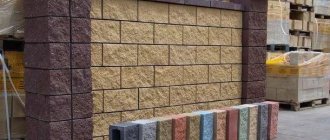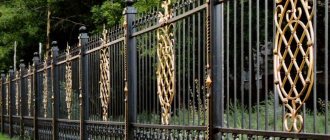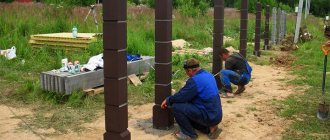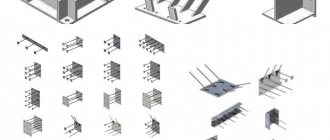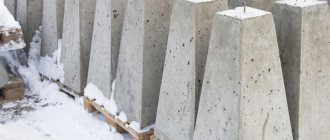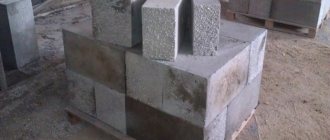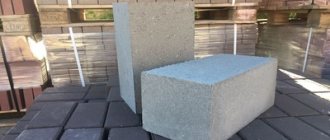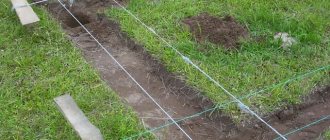Beton-House.com
Website about concrete: construction, characteristics, design. We combine the experience of professionals and private craftsmen in one place
Blocks for concrete fence posts
Having his own house in a suburban area, a person always wonders about the protection of this house. He strives to create a reliable and at the same time beautiful fence around him, which will not only become a reliable fence, but will also please the eye with its appearance.
There are many materials from which fencing around private houses is made. One of these materials is decorative concrete fence blocks.
- Recipes
- Work order
Blocks for fence posts: general characteristics
A vertical structure assembled in the form of a column with a tubular core inside is called a support and is installed on the foundation to ensure the stability of the entire fence. Outside, the load-bearing part of the pillar is lined with decorative blocks made of concrete. Facing elements are characterized by the following indicators:
- dimensions: 25x25x25, 30x30x15, 40x40x20 cm;
- shape in plan - circle, square, rectangle, letter G (when two parts of the element are combined, a cavity is formed);
- the weight of one section is 14-25 kg.
Concrete blocks for fence posts are always made hollow in order to fill the interior space with concrete during installation. The outer surface of the edges imitates the texture and colors of natural stone or brick. The upper part of the inlaid support is covered with a head 130-350 mm high in the shape of a pyramid, ball, or cap to protect it from the destructive effects of rain and snow. Umbrella material: concrete, metal, fiberglass (can be illuminated from the inside).
No. 2. Types of structures for creating concrete fences
To avoid confusion, let's look at the classification of concrete elements that are used to create fences:
- monolithic reinforced concrete sections of decent length and height, with a smooth, less often embossed (diamond-shaped) surface. Such sections weigh several tons, are mounted with special equipment, and are used for fencing industrial enterprises - they are not used in private construction;
- decorative concrete slabs (eurofence) are distinguished by a wide variety and are used for fencing dachas, country houses and private houses;
- decorative concrete blocks They are similar in size to gas blocks and foam blocks, allow you to build a fence as quickly and easily as possible, and are distinguished by the greatest variety of colors and textures.
The last two variants of concrete blocks have become widespread in private construction, and they will be discussed further.
Types of concrete blocks
The design of the facing sections of the fence supports can be with or without grooves, a smooth facade or with a texture, angular. The blocks for the pillars also differ in the manufacturing scheme of the stacked racks - there are 2 types of them.
Decorative
Sections consist of two L-shaped parts. During installation, they are stacked in pairs, forming a cavity inside.
Decorative blocks for fence posts are placed over a support pipe or metal core. The operation is performed in stages from bottom to top, followed by filling the internal void with concrete mixture.
Splitter
The first difference between the design and the decorative sections is that the dimensions of the splitter modules are larger. This allows you to quickly assemble block pillars from such elements. The second feature: the typesetting blocks for a fence post of this type are 2 halves of a solid element.
The assembly of racks of elements is carried out in the same way as the decorative sections are assembled. A concrete mixture is poured into the resulting cavity with a bundle of metal reinforcement.
Technological process for manufacturing fence blocks
The raw materials for the production of decorative sections are crushed natural stones. Mixed in the right proportions and placed in molds, they are subjected to vibration and pressure on machines. The components of the mixture for the manufacture of sections are loose aggregates (expanded clay, sand, crushed stone), binding material - cement, dyes, and other additives that improve the properties of concrete.
Vibrocasting
When making blocks for fence posts, the mixture is molded with the addition of water in an amount sufficient to ensure the plasticity and workability of concrete. The forms with the solution are placed on a vibrating table and are not closed; pressing is not performed.
The compaction of the mass occurs due to vibration for several minutes. The block dries in the mold itself, after which the finished product is removed.
Vibration pressing
This method involves preparing a mixture using semi-dry concrete technology: an insufficient amount of water is added to the bulk components to achieve plasticity. The mass is compacted due to two forces: horizontal vibrations of the machine platform and vertical pressure on the mixture from above.
The optimal ratio of components is selected by trial. Finished products are laid out on pallets for natural or forced drying.
Construction of supports
Scheme for creating a support with additional elements
After all the blocks for the torn stone have been cast, you can proceed to creating the supports themselves. This process is similar to working with natural stone blocks, but there are differences. Since the weight of concrete is much less than stone, a shallow foundation with a depth of one third of the height of the fence is sufficient.
Reinforcement is used for pillars of any height, since the bending strength of concrete is not high enough. Each of the blocks is concreted separately, starting from the bottom. After the concrete has hardened, a small layer of cement is applied and a second block is placed. The top of the post must be covered with a top.
And, of course, don’t forget about the mortgages: they are welded to the reinforcement at the required height, and subsequently sections of the fence will be attached to them.
Advantages and disadvantages
Each of the technologies used for the manufacture of concrete sections gives the product qualities that distinguish vibration-cast blocks from vibration-pressed ones. The former have a smooth surface, but less strength and frost resistance. The latter can withstand a greater number of freeze-thaw cycles and are stronger, but their surface is rough. Both pillar blocks have common advantages in comparison with natural stone and brick:
- Solidity. It is achieved by reinforcing the void and pouring concrete. This design is more resistant to mechanical stress than a support made of brick or stone.
- Quick installation of the pole. The decorative block is larger than a brick, which speeds up installation, but selecting boulders along their edges is a difficult task and takes time.
- Large selection of compositions due to the variety of textures and colors. Posts can be built for any fencing blocks.
- The costs of erecting a fence on supports made of concrete sections are lower than the costs of constructing the same structures from brick or natural stone.
Stacked sections of posts have good compatibility with any fencing materials, be it corrugated sheets, forged metal or wood. Like natural stone, block products last for decades. The only drawback concerns all heavy supports: a foundation needs to be laid under them.
Design varieties
Finished product options for the construction of fence posts
Concrete blocks vary in design and can be:
- with grooves for subsequent installation of fence sections or without grooves;
- for creating corner or row supports;
- with a smooth or textured surface.
You can buy them at any construction supermarket. When purchasing, remember that concrete blocks can be solid or hollow. For self-construction, it is advisable to choose the second option, since the hollow structure is much lighter and there are no difficulties with its reinforcement.
In addition, it is useful to know that factory-made concrete blocks can have different fillers, on which their performance largely depends. The most popular fillers are:
- Expanded clay. The advantage of an expanded clay block is its low weight and attractive appearance.
- Gravel. It has increased strength due to the fact that this type of filler has sharp and small grains, which means their adhesion force is high.
- Granite screening. This block has a pleasant red tint.
- Crushed stone. The result is a product with rounded edges.
- Concrete fight. The blocks have a nondescript, rough appearance. The only advantage is low cost.
When choosing, pay attention to ensure that they do not crumble (this indicates the use of low-quality concrete) and are not stained with oil, resin, and so on.
And finally, if you buy a decorative block, you need to decide on the surface texture. The most common options are those imitating torn stone, brickwork, and slate.
“Ragged stone” surfaces, which have the appearance of chipped stone, are very popular. When making them, first, using the methods described below, a block is formed, the width of which is twice the required dimensions, then it is split into two parts using a special press and a chamfer is created, giving the product a finished look.
Block cost
You can buy ready-made concrete sections in hardware stores or online. At stands and in supplier catalogs there is always a selection of fence blocks for posts. Their cost depends on the following indicators:
- section dimensions - the larger, the more expensive;
- shape - a circular product is valued higher;
- texture - a brick imitation block is cheaper than a natural stone one;
- brand of cement used to make the concrete mixture for making sections: the binder component of the M500 brand gives greater strength to the solution, the block is more expensive.
A high-quality textured section costs approximately 320 rubles per piece, and a smooth block for a pillar costs 120 rubles. Products are supplied wrapped in film and placed on pallets. The production of decorative sections is not a complex process: you can make artificial stones for fence supports yourself.
Technology for installing pillars made of concrete blocks
The construction of the fence begins with markings: the installation points of the support posts are marked on the ground. Depending on the design of the fence fabric and the properties of the soil, the type of foundation for fence posts made of blocks is determined. The final stage is the installation of inlaid supports. All work can be done manually, without the use of construction equipment.
Construction of a columnar foundation
A hole under the base of the stand is dug below the freezing level of the soil by 20-30 cm to prevent movement of the support when the soil heaves. The depth of the excavation does not exceed 1.5 m, and the plan dimensions are taken according to the dimensions of the block plus 50-100 mm. When the pit is ready, proceed as follows:
- 30 cm of sand and gravel are poured onto the bottom of the pit and compacted, after watering with water;
- a pipe Ø60-80 mm is driven into the center of the excavation, the above-ground part - along the planned height of the pillar;
- the pit is filled with concrete, compacting each layer.
For large volumes of excavation work, a excavation in the ground is made with a hole drill.
Strip foundation device
A more powerful foundation will be required when constructing a fence made of concrete blocks. A ditch for it is dug along the entire perimeter of the fence, its depth is 50 cm, and the width is determined by the size of the section of the type-setting pillar with an allowance for the strip foundation formwork. Concreting is carried out in the following order:
- They pour a cushion of sand and crushed stone along the bottom of the trench and line its sides.
- The ditch space is reinforced with the release of rods above ground level to tie the lower row of span blocks. The pillar cores are made from pipes or bundles of reinforcement and are brought to the design height of the fence.
- Concrete is poured.
After the foundation hardens, they begin to install the support blocks and lay the spans.
Features of the device of a strip-column base for pillars
We are talking about a combination of the first two types of foundations. Differences in technology appear already at the excavation stage. The features are:
- Along the bottom of the dug trench, in the places of future pillars, depressions are made for another 1 m. The principles for calculating the size of the excavation in plan and the equipment of the pit remain the same.
- Reinforcement begins with the installation of cores of stacked supports.
- Concreting. First of all, fill the recesses under the pillars with the mixture.
Further actions are carried out using the technology of constructing a strip foundation.
Installation of pillars
Installation of prefabricated supports is done in the warm season to prevent freezing of the cement mortar. The concrete base acquires sufficient strength a week after pouring. Pillars are assembled from blocks by stringing sections onto a pipe. In this case, the core remains in the column cavity. The process is like this:
- Lay out 3-4 rows, align them relative to the plane of the fence and level.
- The internal space of the blocks is poured with concrete, the mixture is compacted, displacing air from the uneven areas.
- The bundle is reinforced horizontally to the backfill mesh or rod.
The cycle is repeated until the full design height of the support is reached. Finally, a protective cap is installed on top.
Famous manufacturers
The following companies have proven themselves well:
- Eurovason. Enterprise in St. Petersburg. The blocks are produced using the “washed concrete” technology. Granite crumbs and pebbles are added to the mixture. Thanks to this, the blocks become very similar to natural stone, both in appearance and in properties.
- "4th Bastion". The company is also from St. Petersburg. Began its activities in 2001. Produces concrete blocks, pillar covers in a choice of textures and colors. Delivers goods throughout Russia.
- "ConstantFence". Part of the group. Began work in 2009. Engaged in the manufacture of fences of varying complexity and designs, including those made from concrete blocks. The warranty on all products is 5 years.
- "SMIC HOUSE". Located in Moscow. Produces construction materials. Delivers to all regions of the country. Product warranty – 3 years.
Each company accepts individual orders for production and also installs turnkey fences.
Do-it-yourself block production
You can look for raw materials for making concrete sections yourself in the vicinity of the fenced area; these can be sand, gravel, small stone chips, broken bricks. You will have to buy cement and molds.
Preparation of concrete composition
The grade of cement is not lower than M400, the aggregates must be dry and free of debris, the water must be clean. Proportions for preparing a concrete mixture for the manufacture of a decorative block of a type-setting support:
- cement - 1 part;
- sand with fine crushed stone - 2 parts;
- plasticizing additive - 0.3-0.5% by weight of cement, pre-dissolved in water.
The mixture is moist, crumbly and should not spread.
Molds for making fence blocks
The concrete mass is loaded into a matrix that has a contour in the form of a concrete block for the fence. To ensure that there is a cavity inside the mold, a void box, a metal container, is inserted. Matrix materials:
- fiberglass - hard and durable;
- PVC - products made from it are inexpensive and provide good quality;
- polyurethane - allows for the application of complex patterns.
It is better to buy molds rather than try to make them yourself.
Basic recommendations for manufacturing
At home, you should use the vibration pressing method - the blocks for the pillars are more durable. Tips for craftsmen:
- follow the recipe for the concrete mixture, add water gradually, mix thoroughly;
- lubricate the working surfaces of the molds and void box with machine oil before loading;
- compact the filled mass with a wooden block, striking the other end with a hammer;
- remove the hollow core upon completion of pressing and disassemble the mold.
The finished block needs to be dried for at least two days, and it will gain its final strength in 28 days. To obtain the desired color, dyes are added to the concrete solution.
